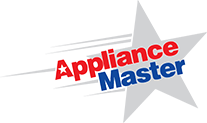Here’s a refresher on keeping cooking appliances clean.
If your burners or oven heat unevenly, or there’s a delayed ignition, call Appliance Master for service before you have a bigger problem!
1. Electric Cooktop:
An electric cooktop with coiled burners will typically burn off any spills. The drip bowls underneath can be easily taken out for cleaning.
For larger spills, wait until the burners are cool, then learn how your cooktop “opens”; most models are hinged and open just like a car hood. This will allow you to clean underneath the burners.
Smooth surface cooktops can be easily wiped clean. Check your manual for recommended cleaning products.
2. Electric Oven:
In an electric oven, the oven racks can be removed and cleaned as needed.
Spills should be wiped up as soon as the oven has cooled to avoid smoking and burning during the next use.
When using a chemical oven cleaner, follow the directions very carefully; the fumes are noxious and the chemical is caustic.
If you have a self-cleaning oven, try to scrape up and remove any residue from the bottom of the oven cavity before you start.
Follow the manufacturer’s instructions and don’t try to force the oven door open until the cycle is completely finished.
3. Gas Cooktop:
Spills on grates and burners on a gas cooktop will usually burn off or you can scrape the residue off. Larger spills should be cleaned as soon as the affected area has cooled off.
If the burner orifices get clogged, you’ll notice uneven flames. To unclog orifices, gently poke a wooden toothpick through. Use of a metal tool, such as a skewer or paper clip, should be done with care.
*Has your burner ever started clicking by itself and doesn’t stop? Either a spill or too much cleaning solution has gotten the spark ignitor wet. Wipe up any excess liquid. Unless the spark ignitor is damaged, it will eventually stop clicking.
4. Gas Oven:
In a gas oven, the racks can be removed and cleaned as needed.
Spills should be wiped up as soon as the oven has cooled to avoid smoking and burning during the next use.
Do not line the bottom of the cavity with foil; it may cover the vents which let the heat from the burner into the oven cavity.
When using a chemical oven cleaner, follow the directions very carefully; the fumes are noxious and the chemical is caustic.
If you have a self-cleaning oven, try to scrape up and remove any residue from the bottom of the oven cavity before you start.
Follow the manufacturer’s instructions and don’t try to force the oven door open until the cycle is completely finished.
5. Self-Cleaning Ovens:
They use extremely high heat (800-900 degrees) to turn debris and residue into a white ash that can easily be wiped up after the cycle is complete.
Before you start the cycle, take the racks out and never try to force the door open until the cycle is finished.








Add comment